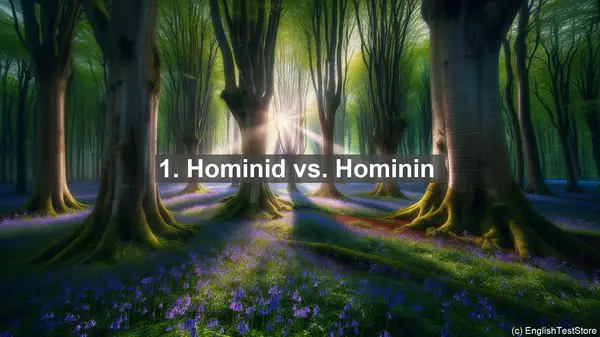Introduction
Welcome to our lesson on the top 10 commonly confused words in evolutionary anthropology. As students, it’s crucial to have a solid understanding of these terms to avoid any misconceptions. So, let’s dive right in!
1. Hominid vs. Hominin
One of the most frequently confused terms in our field is ‘hominid’ and ‘hominin.’ While they sound similar, they have distinct meanings. Hominid refers to the family that includes humans, chimpanzees, gorillas, and their ancestors. On the other hand, hominin is a subfamily that includes only humans and our direct ancestors. So, next time you’re discussing human evolution, make sure to use the correct term.
2. Evolution vs. Natural Selection
Evolution and natural selection are often used interchangeably, but they’re not the same. Evolution is the broader concept that encompasses all the changes in a population over time, including genetic variations, adaptations, and speciation. Natural selection, on the other hand, is a specific mechanism within evolution. It’s the process by which certain traits become more or less common in a population due to their impact on survival and reproduction.
3. Ancestor vs. Descendant
When we talk about the evolutionary relationships between species, it’s essential to understand the difference between an ancestor and a descendant. An ancestor is a species that lived in the past and gave rise to one or more descendant species. Descendants, on the other hand, are the species that evolved from a common ancestor. So, when constructing an evolutionary tree, it’s crucial to place the species correctly as ancestors or descendants.
4. Convergent Evolution vs. Divergent Evolution
Convergent evolution and divergent evolution are two patterns we often observe in the natural world. Convergent evolution occurs when unrelated species develop similar traits due to similar environmental pressures. For example, the wings of bats and birds. Divergent evolution, on the other hand, is when a common ancestor gives rise to different species with distinct traits. An example is the finches in the Galapagos Islands. So, these terms describe different patterns of evolutionary change.

5. Genotype vs. Phenotype
In genetics, we often refer to the genotype and phenotype of an organism. The genotype is the genetic makeup of an individual, the specific combination of alleles they possess. The phenotype, on the other hand, is the observable characteristics of an organism, which can be influenced by both genetic and environmental factors. So, while the genotype sets the potential, the phenotype is the actual expression of those genes.
6. Extinct vs. Extirpated
When we say a species is extinct, it means that it no longer exists anywhere on Earth. However, the term ‘extirpated’ is used when a species is locally extinct, meaning it’s no longer found in a particular region or habitat, but still exists elsewhere. So, while both terms refer to the absence of a species, they have different implications in terms of their global or local presence.
7. Macroevolution vs. Microevolution
Macroevolution and microevolution are two scales at which we can study evolutionary processes. Microevolution refers to the changes that occur within a population over a relatively short period, such as the frequency of certain alleles. Macroevolution, on the other hand, is concerned with larger-scale changes, such as the origin of new species or major evolutionary trends. So, these terms differentiate between different levels of evolutionary analysis.
8. Homology vs. Analogy
When we talk about similarities between species, it’s important to distinguish between homology and analogy. Homology refers to traits that are similar due to shared ancestry. For example, the forelimbs of humans, bats, and whales have the same basic structure, despite their different functions. Analogy, on the other hand, is when traits are similar due to convergent evolution, as we see in the wings of birds and insects. So, these terms describe different reasons for similarity.
9. Fossil vs. Artifact
In archaeology and paleontology, we often come across fossils and artifacts. Fossils are the preserved remains or traces of ancient organisms, providing us with valuable insights into past life forms. Artifacts, on the other hand, are objects created or modified by humans, such as tools or pottery. So, while both are important for understanding the past, they represent different aspects of human and natural history.

10. Monophyletic vs. Polyphyletic
When constructing phylogenetic trees, we aim for accuracy in representing evolutionary relationships. A monophyletic group consists of a common ancestor and all of its descendants. In contrast, a polyphyletic group includes species that do not share a recent common ancestor. So, when categorizing organisms, it’s crucial to ensure that the groups are monophyletic, reflecting their true evolutionary history.
